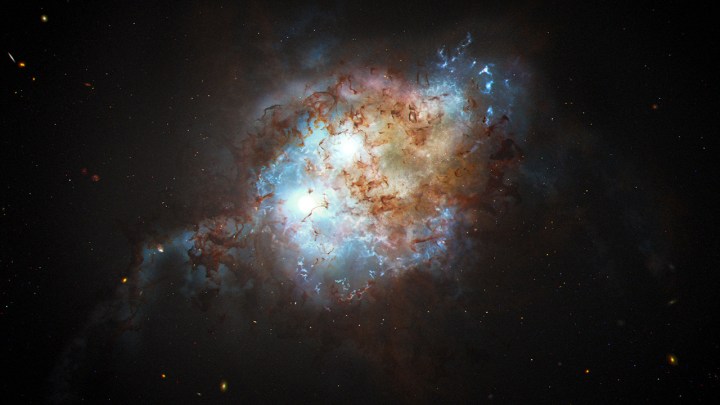The hearts of some galaxies glow so brightly that they are given a special name: Quasars. Powered by supermassive black holes at the center of these galaxies, these regions give off tremendous amounts of light as gas falls towards the black hole and heats up, resulting in a glow as powerful as over 100 billion stars. Recently, astronomers using the Hubble Space Telescope spotted two of these quasars burning brightly in the night sky — and they’re on a collision course.
The pair of quasars, known as SDSS J0749+2255, are from some of the earliest stages of the universe when it was just 3 billion years old. The two galaxies that host the quasars are in the process of merging, and eventually, the two will come together to form one enormous galaxy.

The two black holes are just 10,000 light-years apart, and it will take ten of millions of years for them to merge. That may sound like a long time, but it’s imminent in galactic terms. Observing the pair can help astronomers learn about the early universe and how large galaxies form.
“We don’t see a lot of double quasars at this early time in the universe. And that’s why this discovery is so exciting,” said lead author of the study, Yu-Ching Chen of the University of Illinois at Urbana-Champaign, in a statement. “Knowing about the progenitor population of black holes will eventually tell us about the emergence of supermassive black holes in the early universe, and how frequent those mergers could be.”
It wasn’t easy to spot the quasar pair because they are so bright and so close it is difficult to see them individually. Hubble was able to capture an image showing the two points of brightness thanks to its exceptionally sensitive instruments, with further supporting observations taken using the W. M. Keck Observatory and Gemini North ground-based telescopes.

“The confirmation process wasn’t easy and we needed an array of telescopes covering the spectrum from X-rays to the radio to finally confirm that this system is indeed a pair of quasars, instead of, say, two images of a gravitationally lensed quasar,” explained co-author Yue Shen of the University of Illinois.
This pair of quasars is so distant that we are effectively looking back in time at it, and the pair will have merged long ago. But by studying it as it appears to us today, we can learn about how huge supermassive black holes came to exist when the universe was still young.
The research is published in the journal Nature.



